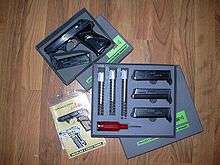Heckler & Koch HK4
| HK4 | |
|---|---|
| Type | Semi-automatic pistol |
| Place of origin | West Germany |
| Service history | |
| Used by | See Users |
| Production history | |
| Designer | Alex Seidel |
| Designed | 1967 |
| Manufacturer | Heckler & Koch, MAS |
| Produced | 1968-1984 |
| Specifications | |
| Weight | 480 g (17 oz) |
| Length | 157 mm (6.2 in) |
| Barrel length | 85 mm (3.3 in) |
| Width | 32 mm (1.3 in) |
| Height | 110 mm (4.3 in) |
|
| |
| Cartridge |
.22 Long Rifle .25 ACP .32 ACP .380 ACP |
| Action | Straight blowback, unlocked breech |
| Muzzle velocity | 356 m/s (MAG-95, MAG-98, MAG-98c) |
| Effective firing range | Sights ranged for 25 m |
| Feed system | 7, 8-round box magazine |
| Sights | Fixed, front post and rear notch, sight radius 121 mmm |
The HK 4 pocket pistol was first introduced by Heckler & Koch in 1967 making it the first pistol produced by the company. Mass production of this pistol started in 1968 and continued until 1984. There were approximately thirty-eight thousand pistols produced during this time. Serial numbers 10001 to 36550 were for commercial distribution. Twelve thousand pistols were produced for the German police and other government agencies in the .32 ACP (7.65×17mm Browning SR) caliber with the designation P11 and were serial numbered 40001 to 52400.
It is thought that the basic design of the HK 4 is based on that of the Mauser HSc. The HK 4 was designated "4" because the pistol had the ability to be modular in four calibers. This means the frame and slide could accommodate three (3) different centerfire calibers by simply replacing the barrel/return spring assembly and inserting the proper magazine for the caliber of choice. The fourth caliber, .22 Long Rifle (.22 LR), requires the extractor faceplate and firing pin be moved to conform to the proper configuration for rimfire operation in addition to changing the barrel and magazine. The three centerfire calibers that the pistol can use are: .25 ACP (6.35×16mmSR); .32 ACP (7.65×17mm Browning SR); .380 ACP (9×17mm Short). Most standalone pistols were sold in .380 ACP and .32 ACP. All four calibers came as a two-box set with the extra barrels, magazines and a screw driver/cleaning kit in accompanying box.
The HK 4 is a straight-blowback, double-action to single-action pistol. With a round in the chamber, a bullet may be fired by either pulling the trigger or by cocking the hammer and then pulling the trigger. The pistol automatically cocks the hammer after a round is fired. The safety incorporates a decocking mechanism that can safely decock the pistol with a round in the chamber. The hammer is decocked by putting the safety in the "safe" position and pulling the trigger, which allows the hammer to fall without striking the firing pin. When using center fire cartridges, there is a red marking on the top of the extractor that serves as a "chamber loaded" indicator. This feature has continued in current H&K pistols. The pistol incorporates a plastic buffer in the frame. The buffer, which is loosely installed in the frame, can be lost during cleaning or can wear out and needs to be replaced periodically.
The pistol is disassembled by removing the magazine, cocking the hammer and putting the safety in the "safe" position. A notch inside the front of the trigger guard at the frame must slide down and be held in position while moving the slide slightly forward and then up to detach it from the frame. The barrel can now be removed from the slide. To reassemble the pistol, insert the barrel back in the slide. Place the slide into the guides in the frame. Move the slide to the rear to re-seat the slide and lock it in the rearward position on the frame. Pulling the trigger releases the slide into the neutral position.
The pistol is converted to the .22 LR configuration by first disassembling the pistol and removing the barrel from the slide. Hold the extractor in the fully extended position by inserting a needle into a hole in the extractor. When purchased new, the pistol came with a screw driver that incorporated a cleaning chain in the hollow handle. The screw driver is designed to be inserted into the barrel guide in the slide without scratching the slide. Using the screw driver, the screw is removed from the extractor faceplate and the faceplate removed from the slide, being careful not to dislodge the small spring on the end of the firing pin. The faceplate is then flipped over and replaced in the slide so that the firing pin is inserted into the upper hole of the faceplate for rimfire operation. The screw is then reinserted into the faceplace. When the faceplate screw is fully tightened, it is important to note that the screw head will protrude from the faceplace slightly and will not be flush with the faceplate as with the centerfire configuration. Insert the .22 LR barrel into the frame. Remove the needle to allow the extractor to return to its operational position. The slide is replaced in the frame and the .22 LR magazine is inserted to complete the conversion. In the .22 LR configuration, the extractor remains extended and always shows the red marking on top. This means that when the pistol is in the .22 LR configuration, the extractor always indicates "chamber loaded", even when the chamber is empty.

Users
References
External links
| Wikimedia Commons has media related to HK4. |